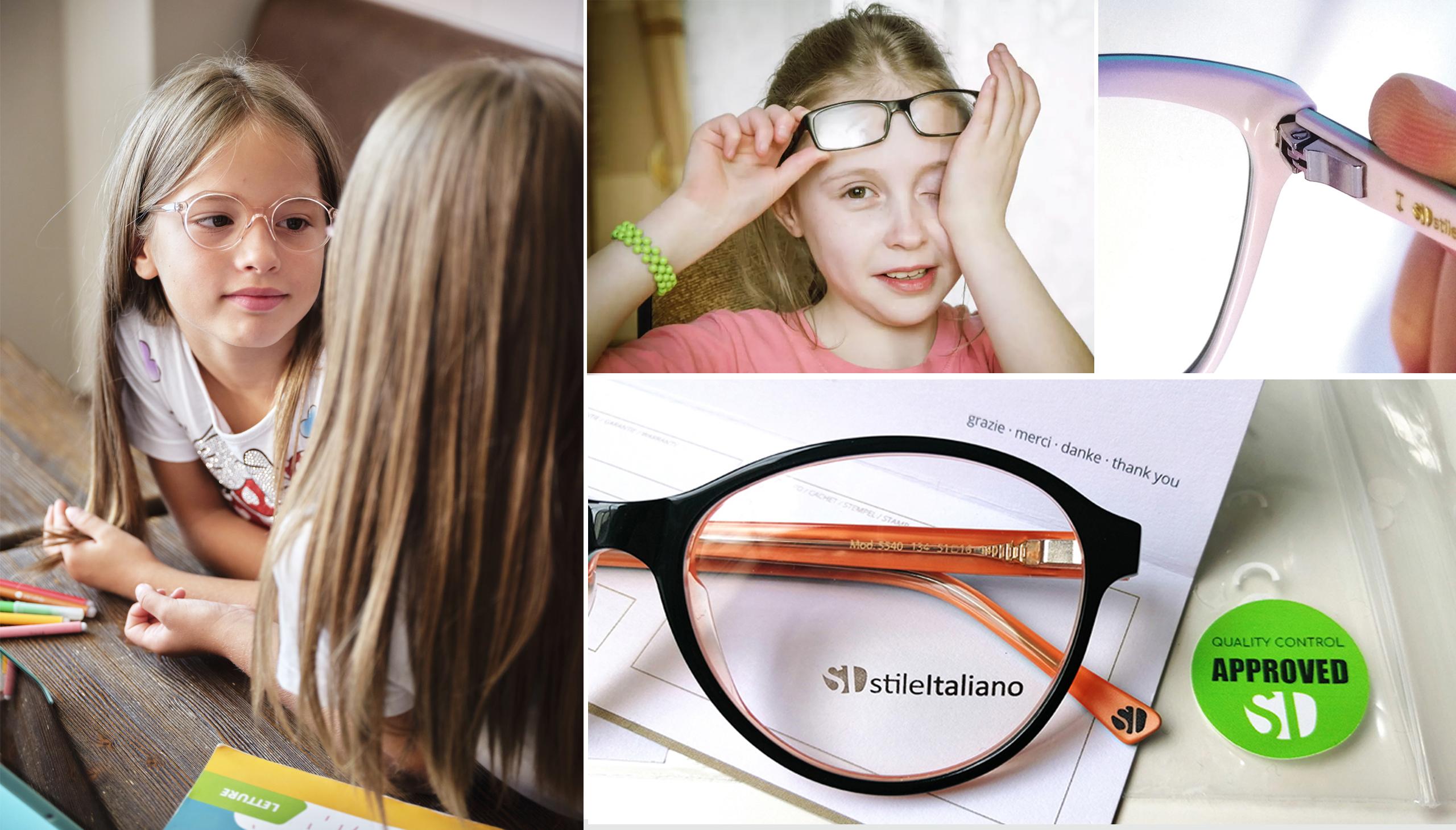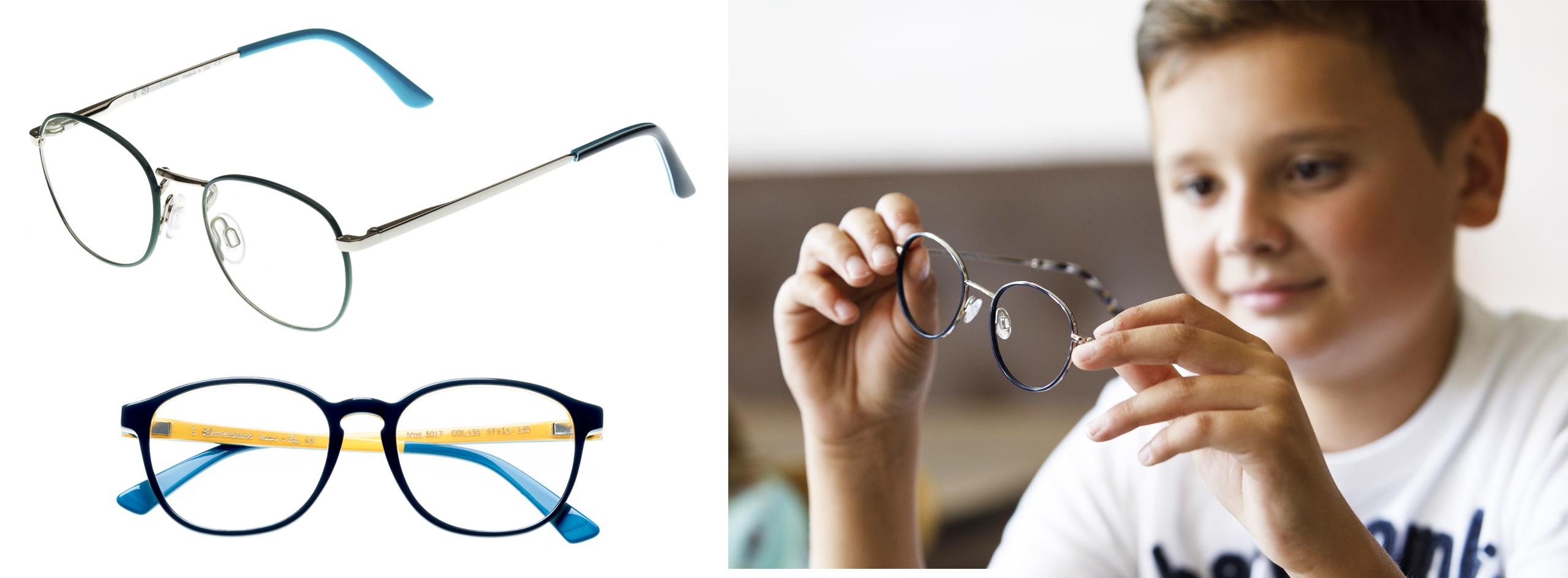⏱️ 04:50 MINUTI DI LETTURA
You have bought a new pair of glasses and you can’t wait to wear them. Don’t forget to take as much time as you need to get used to the new “set-up”. It is absolutely normal at first to visibly perceive the edge of the frame or to feel differently the presence “on” of the new eyewear. For some it takes only a few days, while for others it may take more than a week. It happens, in fact, that the visual center of our brain has adapted and therefore compensated for the old vision, and therefore needs a short period to adapt to the new improved visual conditions.
So, it is very important you to wear the new frame constantly to let your eyes get used to it, and to see if the situation improves and the problems disappear for good.
Sometimes, however, your expectations turn out to be disappointing: wearing your new glasses is not so comfortable, indeed! Fortunately, there is a solution to everything. Our advice is to buy your glasses from a trustworthy reseller, able to ensure your satisfaction even through some several different solutions.
Here are some more or less common problems you may run into when wearing new glasses.
1.Blurred vision. There are two possibilities: either you are wearing glasses with wrong lenses or your sight is getting worse rapidly. In both cases, we suggest you go back to your ophthalmologist and let him check the lenses. If they DO NOT correspond to what prescribed by the doctor, the optician will simply have to redo them. Should the lenses match instead the prescription, your sight may have changed in the time-lapse. The reasons can be different but all equally feasible and important:
a) Stress changes your sight. We advise you to undergo the eye examination in total relaxation, since stress can badly influence your sight as well as it does with blood pressure and heart. The results might be therefore distorted and you may run the risk to get unsuitable corrective lenses.
b) Chronic diseases. Some of them, such as diabetes or hypertension, have an important impact on sight. They can sometimes cause a sudden worsening of the situation. The only solution is then to schedule a frequent check-up. In this case, there is no blame for the optician or for the person who prescribed the lenses;
c) Take medicines. Some of them can temporarily change your sight. We recommend you to inform your eye doctor about this so that he can proceed with the suitable prescription and make the right considerations.
2. Reflections: if you notice reflections on the inside of the lenses when wearing your glasses, it means that the anti-reflective filter is most likely missing. We always recommend it because it avoids annoying glare of light that leads to visual fatigue, interference during night vision and sometimes even hindrance of eye contact. Ask the optician if this treatment is included and if it is not, ask for it to be added to the lenses.
3. The new glasses slip from the nose: this situation is very easy to solve. You have only to adjust the temples by bending their ends and be careful they do not rest directly on the bone behind the ear, otherwise you can feel a certain discomfort. If the frame has nose pads, then you can act on them by increasing the grip on the nose. This problem may happen with both new and long-used frames.
4. The first time with progressive lenses: This is an important step and it may take some time. You have to desist from moving or lifting your neck and wait for your eye to react to the stimulus of the lens. If you really feel uncomfortable and that you have dared too much, then your optician could replace them with different multifocal lenses. The change could also be made under warranty with bifocal or single vision lenses (less expensive).
5. You don’t like eyewear anymore: you’ve tried it and tried it again, yet now you realize you don’t like it anymore. What can you do? Some optical stores allow you to return the frame within a certain time lapse: they then replace it or offer you a coupon on your next purchase. Since eyewear is an important investment, it is a good idea to check whether or NOT you have this option before proceeding with the purchase, especially if you are not 100% convinced. Some opticians offer the possibility to replace or receive a refund at no extra costs, others ask you to sign up for a policy and still others replace the eyewear upon payment of a small fee.
6. And what about sunglasses? You can’t do without UV protection, but you didn’t think of it right away. There are two solutions: either you buy a second pair of glasses with graduated lenses or you decide to replace the lenses you have just purchased with a pair of photochromic ones that can protect you in the same way from UV rays.

As you have read in the cases listed above, it is important to understand when you should take out an additional insurance policy and which one. A good policy provides for the replacement of a part or the entire glasses if there are defects in the frame or the replacement of the lenses if they do not correspond to the initial medical prescription or if the prescription itself was incorrect. As previously mentioned, if you believe that the lenses have not been made correctly, we advise you to contact the ophthalmologist who carried out the visit. He is the only one who can verify the accuracy of the powers and compare them with your vision. There should be usually no additional cost for this type of consultation. But be careful, the policy may provide for the free replacement of the lenses only once within a certain period of time.
If the policy provides for it, you can get the money paid for the purchase back.
All damages, however, caused to the glasses, are practically NEVER covered by the insurance you take out. The optician knows this very well, he can recognize when a pair of glasses has suffered a blow, or a sudden stress leading to the break. Especially when it’s a high quality frame, it will hardly break. And moreover, it is impossible for it to break, even by itself.
So, let’s remember what to do when we are going to buy a new pair of glasses:
• Go to your trusted optician, the one who has always known you and is able to find the best solution for you.
• Have your eye examination in the best possible conditions and inform the doctor if you’re taking any medicine that can change your visual perception.
• Choose certified quality lenses, as well as the frame. A quality frame increases the longevity of the optical instrument thus amortizing your investment.
• Decide which filters your frame’s lenses should have. We recommend the anti-blue, anti-reflective and photochromic filter, if you don’t plan to buy sunglasses as well.
• Choose the frame that suits your face. That’s easy! (We recommend you to read our blog “to each his own … GLASSES!”)
• Decide how many pairs of glasses you need, also depending on the uses you intend to make with them (eyesight, sun, eyesight/sun, sports). It may be that on the second or third pair of glasses you buy, you can get some interesting discounts.
• Carefully consider if and which insurance you’d better to take out to cope with unexpected events.
And remember, it’s always a good habit to train your eyesight. As we age, the eye muscles also get old and their responses slow down. Help yourself with simple and quick exercises. Find them here in our blog.
Always choose responsibly.

⏱️ 03:10 MINUTES OF READING
It’s time to buy the first pair of glasses for your child. How can you choose the right one? And more important, how can you get him/her to wear them?
In this article, we have collected a list of important tips that will help to get your child to wear glasses comfortably.
It is important not to say anything negative on any glasses the child chooses to try, as such comments could be seen as a personal attack and lead the child to completely retreat into a shell and refuse any kind of suggestion.
The following recommendations have been compiled starting right from the perception that the child might have of this new thing. And it is known that most of the time wearing glasses is just a nuisance for them. The good news is that if they are worn correctly, they are an annoyance only at the beginning.

Before embarking on this adventure, it is important to evaluate how long the glasses will be worn during the day, all the time or occasionally? In the first case, it will be necessary to consider more things. The second case, instead, is easier and allows to try a more “original” frame.
So, we decided to list here ten keywords to help you find the glasses that the child will want and accept.
WISHES
Let your child express himself/herself freely! As we already mentioned in our previous article, children often want to look like their favourite superhero more than like their parents. So ask him to express his choice! It’s important to remember that the child might go through this experience as something unpleasant, so do not suggest a frame that will make him feel uncomfortable but rather try to find something positive in any of his choices.
This is very important for everything that will follow once you are home. If the child associates the glasses with negative emotions right from when he tries them on the first time, this uneasiness will most likely carry over into the everyday life and he will not be so happy to wear them.
BROTHERS/FRIENDS
Based on our experience, we recommend involving in this choice one of your child’s friends, maybe one who already wears glasses, or an older brother who can tip them on the latest trends. This way, the child will feel the support of someone more similar to them as well as that of the parents.
MATERIALS
Acetate or metal frame? You’re probably asking yourself which material is better. The main difference between the two frames is the bridge. The nose of children is not completely developed yet and so some acetate frames are often not firm, they slip and become uncomfortable to wear. Eventually, they will be forgotten in some places, thus risking the worsening of the child’s visual impairment. Today, acetate frames are designed with a smaller bridge to better address this need. This issue can be bypassed in metal frames as there are nose pads that you can adjust and that can guarantee a better fit on the child’s face. On the other hand, acetate has a less angular, rigid and austere look while being light and robust at the same time. In addition, it can be more colourful and attractive, creating really interesting and original combinations. Regardless of which material you prefer, always make sure to choose a HYPOALLERGENIC frame to avoid any tolerability issues.
TEMPLES
This choice depends on how much time the child will spend wearing the glasses. If they are only worn occasionally, perhaps while reading in the evening or doing the homework, then there are no particular requirements. If, instead, they will be used throughout the day, and even more if they are the child’s first glasses, we recommend considering temples with flex hinges as they are strong and sturdy and will increase the durability of the frame during the different activities done by the child during the day. The cost will be slightly higher but it’s just a small investment that over time will be completely repaid.
It could be also useful considering temple tips slightly larger than normal in order to increase their adhesion. This can be increased with the use of a lanyard – they come in many types and colours – which allows to tie the glasses behind the head preventing them from falling off and breaking.
LENSES
The lenses can be made of different materials. Ask your optician for the most suitable one for you. There are lenses in plastic and glass. Normally the first choice for a child is plastic because it’s lighter and also because it doesn’t shatter in case of impact avoiding possible damage to the eye.
WARRANTY
Your optician may recommend an additional warranty that allows the replacement of the glasses or the lenses in case of breakage. Make sure you are told what is included in the warranty and especially what is not, so as not to have any questions in the future. This service is recommended if the glasses will be worn throughout the day or during sport activities. Of course, it becomes almost essential if they are the first pair of glasses you buy for your child!
SECOND PAIR
Always consider purchasing a second pair of glasses, especially if the child suffers from severe visual impairment and must wear the glasses all day during all his activities. A second pair will ensure that your child will always have eyeglasses available when needed.
AWARNESS
An important task that parents should not underestimate is the need to make the child understand why he has to wear glasses, perhaps proposing activities to be done together, e.g., reading with and without glasses to be able to notice the difference.
ROUTINE
The reason your eyeglasses are the right ones is that they become right day by day. You’re probably wondering what that means?! Once you have chosen the glasses, perhaps the optician’s work is finished but not yours, as you will have to make sure that the child wears his new trusted friend on any due occasion.
This is a delicate period, especially if they are the child’s first glasses. So we recommend that you encourage your child to wear the glasses using some tricks. Reassure him that you feel proud that he is wearing the glasses without any complaints. Also, do not reproach him too much for not wearing the glasses when he should. On the contrary, praise him when he wears them of his own accord without needing anyone to remind him. Or take some selfies that you can store to look at them together. Another possibility is to convince the child that the glasses will allow him to enjoy more his favourite cartoon.
PATIENCE
It’s the last but not least word on this list. You need patience when your child will not be able to decide on the glasses he wants, patience when he will struggle to wear them at home, patience when by chance they will fall on the ground and get damaged. Patience meaning a hand stretching out ready to support them during this new and somewhat difficult moment in their children’s life.
We trust that these guidelines will help you to ease your child’s first experience with eyeglasses, so that he can better deal with his visual impairment.
Check out our blog and stay up to date with our latest news!

⏱️ 04:20 MINUTES OF READING
Despite all the attention that we give to our children, sometimes they encounter obstacles or problems in their life that they need to deal with and accept. With you by their side though, everything will be easier.
One of the things that is important to monitor since the first few months of life is the child’s sight. Why is it important to have an eye examination in the first years of life? Though newborn babies are able to see, they are not able to focus their eyes yet. Their vision develops in a subsequent period and for this to happen correctly, the brain NEEDS to receive clear images from both eyes. If that doesn’t happen, their vision can be compromised, even severely in some cases.
Being able to see well is a matter of the utmost importance. Imagine having to grow up in a blurry world, difficult to understand and especially recognise because it is not clear, perhaps with frequent ailments and unavoidable discontent. It’s important to remember that sight is one of the 5 senses and, in particular, it is the one which plays a decisive role in the child’s psychomotor development, especially in the first 10 years of age. Sight is a FUNDAMENTAL sense on which concentration, lucidity and efficiency depend; abilities that are indispensable to live life to the fullest.
The eyes of children are important to us. That is why we want to sensitise you to some signs in the child’s behaviour which could be the consequence of a sight defect.

The first thing a parent has to check in a newborn, at around 3 months, is whether his eyes are aligned properly, as even the smallest misalignment could be the sign of a sight defect that needs to be corrected. Or also if the child’s eyes are too big or too small, if one eyelid is lower than the other, an iris with irregular shape or colour. It would even be good practise to prepare in advance for an examination if during pregnancy the mother contracts infectious diseases such as rubella, toxoplasmosis, etc, or if the baby has some pain during childbirth.
If a parent suffers from diseases like retinitis pigmentosa, strabismus, congenital cataracts, congenital glaucoma (just by reading them you get scared, don’t you? All these strange words!), also the child could be afflicted by them as a result. It is precisely for this reason that they should always be taken into account and monitored. Of course, it often happens that these diseases are not triggered, but it is still important to have periodic check-ups.
It’s also important to monitor posture and behaviour in a young child. Starting from 3 months of age, if he struggles to follow an object moving slowly or if he has difficulty grabbing objects, these could be the sign of a vision defect, especially if the behaviour does not change in the following months. It is appropriate to see a doctor if the child falls frequently or has difficulty in avoiding obstacles.
Pay attention also when he watches TV or reads a book. If he sits too close to the TV or puts the book closer to the face to read better, he could suffer from myopia.

When children learn to read, they often use their finger to keep track of the line they are reading, in particular the words. If he keeps using this system also in the following phases, try asking him to read without following the text with his finger. This method will allow you to understand if it is just a habit or if he frequently loses track of where he was reading. In the latter case, an eye examination is appropriate.
Does your child close an eye and use only one of his eyes to watch TV or read or when sitting at the computer? This behaviour could indicate a refractive or binocular vision, connected with convergence insufficiency.
Another sign that sometimes indicates a sight defect is the rubbing of the eyes. It may happen that during the day your child rubs his eyes with his hands. It is normal if this happens when he is tired or bored, but if he rubs his eyes when trying to focus or read or during any other activity, it is very likely that his vision is causing him trouble and discomfort. This is also true for children with a high tear flow, which can be noticed by residues of secretions on eyelids and eyelashes, or children with excessive sensitivity to artificial or natural light. In some cases, these problems could even lead to recurrent migraines.
Be careful though! Also school marks are always a sign of something else! Indeed, children are like small champions who would never dream of disappointing us, so if your child starts bringing home worse marks than usual, then it could be caused by the inability to see the blackboard well. Probably, if he is not able to see well what the teacher writes, his notes and learning will decrease and almost certainly, because of pride, he won’t tell you what happens in the classroom. Do not hesitate to ask their teachers for help. As they spend a lot of time with our children, they should already be used to some of the behaviour of their students, so ask them how your child behaves in class while he looks at the blackboard or tries to read. If he squints or tilts his head to one side, then it is clear that he has some difficulty which needs to be evaluated by an eye doctor. In the meantime, ask the teacher to move him closer to the blackboard. Alternatively, you can do some tests at home. It’s your choice.

Let’s talk now about the child’s diet! You are probably wondering what food has to do with eyes and sight. It may happen that a diet rich in sugars leads to a high insulin level, which sometimes affects the quality of the child’s sight. In this case, a healthy diet that limits gluten and sugary foods can produce a significant improvement, without having to resort to eyeglasses and corrective lenses.
We all know that sight plays an important role in everyone’s life and that it allows us to develop our confidence and independence. Wearing eyeglasses to correct a sight defect could look bad at the beginning, but over time, they will become like travel companions that you will always want close! In fact, you need to choose them carefully. Some sight defects can be corrected and eliminated, others, instead, will always accompany your child. What’s important is to act immediately, so that your child will be able to look at the world around himself and see it alive, full of bright colours and rich in nuances.
Advice:
We live today in a new era. Even at a young age, children are constantly using electronic devices such as PCs, tablets, mobile phones and Smart TVs which tire their eyes all the time. The actual culprit of all this is BLUE LIGHT. Try then not to expose your children to these devices too much in order to avoid long-term damage that is still partly unknown. We will talk about this problem more in detail in the next article. Stay up to date… 🙂
Check out our blog and stay up to date with the latest news!
⏱️ 03:10 MINUTES OF READING
They are the most coveted customers, the ones that can only be won with patience and understanding: CHILDREN. Choosing together the frame that best suits them can represent a fun and informative experience for both.
In this article we want to tell you about a special type of customer that requires special consideration from opticians during the sales phase. We will also analyse the most popular trends in choosing the perfect frame for the little ones.

Of course, we need to ask the child this question: which pair of glasses do you want? Most answers fall into one of these two categories:
- I want the same glasses as…
- I want the glasses of my favourite superhero (their current idol).
This way, we already have two guidelines that can allow the optician to figure out which glasses to suggest.
On the one hand, children try to imitate adults, especially people they admire and people who listen to them. It could be a parent, an older brother/sister or even their best friend who also wears glasses. For this reason, besides technical frames, your collection must also include some with a more classic line that can remind adult glasses in miniature. It doesn’t matter if the frame is made of acetate or metal, they must look similar to those of the “adults”. We can overlook the colours for now; children always like them.
On the other hand, children may be inspired by a character from a cartoon, by a popular rapper or even by a superhero. In this case, apart from the shape, it’s also important to consider the colours! Of course we still need to find a frame that suits them, but especially the colours that represent their idol. Colours that are sober and that can always be worn casually but that hide a rebel soul, just like the idol our little adults admire and want to imitate!
And you know, being able to sell the right pair of glasses to a child means also conquering the parents and hopefully the whole family!

Analysing the situation through the eyes of a parent, you will be able to learn about the new needs that generate the different trends. We will discuss this later and list a number of points to take into account during the selection phase of glasses for children. The primary requirement is always durability and quality though.
We must also consider a small detail that cannot be ignored. Especially at the beginning, the child won’t be so happy about the glasses. They are often seen as a hindrance to their freedom of movement and as a task because they must pay attention to how to wear and how to remove the glasses without breaking them.
No product is indestructible but it’s still better if the child wears a frame of higher quality than average to ensure greater durability over time. Also the lenses can considerably increase the total cost, especially if you have to create them to correct a major ocular dysfunction. It is not the right choice then to choose an economic frame as if it were to break, it would be difficult to find the spare parts and it could be necessary to pay again for a new pair of glasses.
How can we help parents to make the child understand the importance of wearing glasses? It’s not a secret. Actually, the answer is very simple: we need to involve him and make him the central part of the entire process of choice. This way, the child will get the glasses he wants and it will be easier for him to accept and wear it. He will be happy about them and what initially was cause of discomfort will turn into a source of pride and uniqueness!
Unfortunately, not everyone thinks that it is important to listen to the wishes of the child and often they receive glasses that are functional, of course, but horrible to their eyes. This makes it difficult for the child to get accustomed to them and to create a routine that will allow him to wear the frame automatically and casually.
We recommend that you always remind customers, especially parents, that wearing a glasses is not like wearing a shirt that you may like or not but that has the sole purpose of covering the body. A pair of glasses is an instrument that must be worn for the physical and mental well-being of the child himself; the same way an adult would never wear glasses that he does not like, also a child will probably do the same. And as we said at the beginning, remember: a satisfied child becomes a loyal customer… he will soon return (not considering fashion, of course) because he will grow up and will need a pair of glasses that suits his new teenage needs!
Check out our blog and stay up to date with the latest news!
Good. As the previous articles showed us which tools we need to use to bring the customer in our store, now it is useful to understand how to establish a relationship with them and turn them into active customers. Possibly, concluding with the sale of a nice pair of glasses with progressive lenses! ?
Nothing is ever easy though. A sale doesn’t just mean giving some product in exchange for money. Selling is an art and so, even when it doesn’t come naturally, fortunately it can be learnt. You work closely with customers and tackle this topic every day, but have you ever thought about what technique to use, about an intelligent sales strategy?
Not everyone realises that smart selling consists in the analysis of the person you deal with, in understanding quickly what his needs may be, in being able to create new needs in the customer and suggesting the right product. That’s the secret, leading the customer towards his choice. But it’s so difficult, isn’t it?!
A good salesman knows how to sell. A great salesman knows how to sell himself. The choice is yours; which of these two categories will you choose to belong to? Being able to sell yourself means guiding the customer towards their purchase. A technique that is surely effective in the sales phase. But how can you do it if every customer is a different individual with a different approach to purchases?
There are customers who enter your shop because they are accompanying someone, customers who are attracted by some glasses they saw in your shop window, customers who want to know if you sell a product that they have seen in the newspaper or worn by a friend, customers looking for the best price and finally customers who need to buy a pair of glasses and have decided to do it right in your shop. The last example seems to be the easiest, right? If the client is convinced, has clear ideas and is motivated, what else do you need to close the deal?! But things are not like that and more than anyone else you should know it.
Even though a motivated customer looks easier to deal with, because he is convinced and thinks he knows what he wants to buy, the truth could be different. It’s now that you need to play “the game”.
Even if the customer has a specific model in mind or has already chosen, it often happens, especially in the eyewear sector, that the model he wants is not the one that suits him best, the colour doesn’t go well with his hair or he simply does not like it anymore. Did you ever lose a sale at the last minute because of a disagreement, some misunderstanding or non-alignment with the customer’s needs? How many times have you asked yourself what you could do to better understand the needs of the customer, to understand them even when the customer does not know what he wants and even if he is convinced that this is not the case?
In this case, the only thing we can do is use a tricky communication technique that in some situations, but not always, can prove to be very effective: delaying the time of purchase. When applied carefully, this technique is very effective. Beware though. It has some limitations that you need to take into account to avoid annoying or irritating the customer with too much insistence or with the wrong questions.
The type of customer who is really perfect for this technique is the one who, entering your shop, does not want to disclose immediately how much money he wants to spend and maybe asks for a specific model. It’s right then that you salespeople have an ace up your sleeve that you can take advantage of and take time. The people who ask for a specific model do it because they have already done some research on that product. It is appropriate then to establish a communication, apparently relaxed, based on anything that is not necessarily related to your products or the eyewear industry. In this case it’s important to establish a connection with those in front of you.
Ancient wisdom has it that the amount of time that passes from when you express a desire to when you satisfy it can only increase the pleasure of the final realisation. By delaying time with that customer, you can only get two precise results: on the one hand, you increase the customer’s impatience to have his request fulfilled (and you have to use caution not to cause boredom or disappointment), and on the other hand, by showing interest in him, you create a positive experience for him.
A different case is when the customer, even before saying hello, asks for information, for example, about the cost of a product:
in this case, it is quite clear how
“cost-oriented” he is and there’s really very little you can do. It does
not mean though that you have lost “the battle” if the price does not
correspond to what he wanted. You need to answer any question about the
price in a straightforward manner, paying great attention to non-verbal
communication and trying to figure out what sort of reaction the
information may have caused in him. The ability to observe can help you
to regain lost ground as it allows you to understand if there’s room for
negotiation and a way to learn more about the customer and his needs.
The proper approach could be a question about what made him choose that
specific model. This can significantly help to establish a dialogue with
him; a good step forward!
If you extend the time between the customer’s arrival in the shop and the moment his request is satisfied, he will be affected by precise dynamics: the customer will transform from a “motivated” customer to an “active” customer.
Sadly, there are times when your proposal or the initial choice is not satisfactory. What can be done if in the end the desired product is not suitable? We need to provide an alternative!!! Things become more difficult because a motivated client has just turned into a hesitant and disappointed customer. Suddenly, the certainty of having found the perfect pair of glasses for him has vanished. And now?
There is a rule in behavioural psychology that says: “give other people a choice to make”; it means that when facing a choice, our mind is manipulated towards that option. Of course, it is the customer who in the end will decide what to choose but the terms of the choice will have already been devised by you in advance. By then, you will have a great advantage.
A great salesman, through an open and reassuring attitude, including gestural communication, must be able to gain the customer’s trust, making him understand that he doesn’t need to be demoralised if he has not yet found the right glasses. Your professionalism allows you to provide him with alternative options that are based on the brief conversation you had with him and your curiosity towards his needs. This will allow you to make a final and decisive proposal. It’s important that you give the customer time to make his own choice.
That’s it. Your goal is almost achieved because by doing so you have sent this message to his brain: Okay, this optician thinks like me and understands what I need, now it’s up to me to make the final choice.
It is a matter of moments, intense tenths of seconds during which the customer decides whether to play that game or move on. If he decides to play, you will have the opportunity to start a dialogue. The customer will be “driven” towards a solution, whatever it is, though in line with its real needs.
This way it’s quite likely that your goal will be achieved. You will sell the glasses and obtain an active customer who will feel important and unique. A customer who after this positive and satisfactory experience will certainly return to your shop!
Check out our blog and stay up to date with the latest news!

